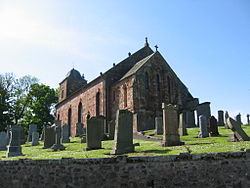Prestonkirk: Difference between revisions
Created page with "{{Infobox town |county=East Lothian |picture=Prestonkirk.jpg |picture caption=Prestonkirk Parish Church |latitude=55.985 |longitude=-2.681 |post town=East Linton |postcode=EH4..." |
No edit summary |
||
| Line 5: | Line 5: | ||
|latitude=55.985 | |latitude=55.985 | ||
|longitude=-2.681 | |longitude=-2.681 | ||
|population=2,185 | |||
|post town=East Linton | |post town=East Linton | ||
|postcode=EH40 | |postcode=EH40 | ||
Revision as of 10:05, 14 April 2016
| Prestonkirk | |
| East Lothian | |
|---|---|
 Prestonkirk Parish Church | |
| Location | |
| Location: | 55°59’6"N, 2°40’52"W |
| Data | |
| Population: | 2,185 |
| Post town: | East Linton |
| Postcode: | EH40 |
| Dialling code: | 01620 |
| Local Government | |
| Council: | East Lothian |
| Parliamentary constituency: |
East Lothian |
Prestonkirk is a parish a little north-east of the centre of East Lothian. It contains the villages of East Linton, and Old Preston. Clockwise, It is bounded by North Berwick, Whitekirk, Dunbar, Stenton, Whittinghame, Morham, Haddington, Athelstaneford and Dirleton. Originally, and so early as the 12th century, the parish was called Linton; during some time before the Reformation, it was called indifferently Linton and Haugh; after the Reformation, it was called Prestonhaugh; at a later period it got its present name of Prestonkirk.
The parish is bisected east-west by the A1 Great North Road as well the railway equivalent, the East Coast main line, originally part of the North British Railway. There are no stations in the parish as that of East Linton was closed in 1964.
Baldred, who flourished in the latter part of the 6th century and the beginning of the 7th, was long the tutelary of the parish, and is said to have dignified it by his residence, and founded its earliest church. Preston, the site of the church, was one of three villages which contended for his body after his decease. His statue long lay in the burying-ground, and was intended to be built into the church wall, but was broken in pieces by an unromantic mason. On the farm of Markle stand the ruins of an ancient monastery, considerable in extent, but unrefined in architecture, of whose history little is known.
| ("Wikimedia Commons" has material about Prestonkirk) |
